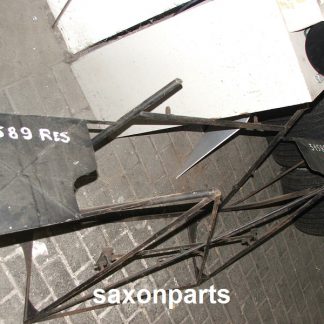Beschrijving
Front subframe of the Ferrari 512 BBLM 1979-1982.
New.
Shipping world wide possible.
Email us at info@saxonparts.com
The Ferrari Berlinetta Boxer is one of a series of cars produced by Ferrari in Italy between 1973 and 1984. They used a mid-mounted flat-12 engine, replacing the Daytona, and were succeeded in the Ferrari stable by the Testarossa. It was designed by Leonardo Fioravanti.
Production of the BB was a major step for Enzo Ferrari. He felt that a mid-engined road car would be too difficult for his buyers to handle, and it took many years for his engineers to convince him to adopt the layout. This attitude began to change as the marque lost its racing dominance in the late 1950s to mid-engined competitors. The mid-engined 4-, 6-, and 8-cylinder Dino racing cars were the result, and Ferrari later allowed for the production Dino road cars to use the layout as well. The company also moved its V12 engines to the rear with its P and LM racing cars, but the Daytona was launched with its engine in front. It was not until 1970 that a mid-engined 12-cylinder road car would appear.
Power: 360 hp (268 kW) @6200 rpm
Torque: 46 kg·m (450 N·m; 330 lb·ft) @ 4600 rpm
Max. RPM: 6600
Max. speed: 303 km/h (188 mph)
0–100 km/h (0-62 mph): 5.4 secs
Dry weight: 1,515 kg (3,340 lb)
In 1974, Luigi Chinetti’s North American Racing Team (NART) developed a racing variant of the 365 GT4 BB to replace the team’s Daytonas for use in sports car racing. NART’s car debuted at the 24 Hours of Daytona in 1975 before earning a sixth place finish at the 12 Hours of Sebring two months later. NART continued to use the car into 1978, by which time Ferrari had begun their own development of a racing variant of the updated 512 BB. Ferrari’s Customer Assistance Department extensively modified four 512s in 1978, adding wider wheel arches, a roof-mounted aerofoil, and reusing rear wings from Ferrari 312T2 Formula One cars. Power from the flat-12 was increased to 440 hp (328 kW) while the cars’ weight were decreased to approximately 1,200 kg (2,646 lb). The three cars, termed BB LM by Ferrari, were entered by Charles Pozzi, Ecurie Francorchamps, and NART in the 1978 24 Hours of Le Mans, but none were able to complete the race.
After the failure of the first batch, Ferrari worked on fixing the BB LM with a second development program in late 1978. The flat-12′s carburetors were replaced with an electronic Lucas fuel injection system to increase power to 480 hp (358 kW), a system later adapted to the 512i BB. The production-based bodywork of the first BB/LMs was replaced by a new design developed by Pininfarina which was 16 in (41 cm) longer and carried over none of the original styling cues. The pop-up headlights were now replaced by fixed units integrated into the fascia, while the tail was lengthened to the maximum allowed by regulations. Nine of these revised BB LMs were built by Ferrari in 1979, while a further refined series of sixteen were built from 1980 to 1982. Amongst the BB LM’s best finishes was a fifth overall and first in the GTX class at the 1981 24 Hours of Le Mans.






Beoordelingen
Er zijn nog geen beoordelingen.